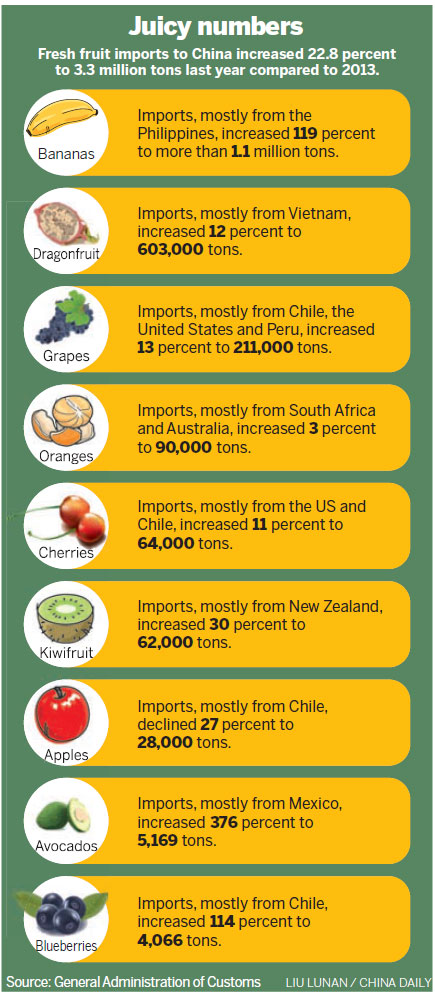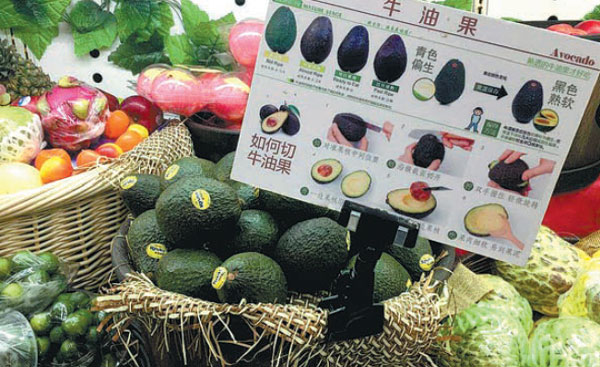Avocados find sweet spot for surge in growth
Updated: 2015-07-01 15:06
By Emma Gonzalez(China Daily USA)
|
|||||||||
Demand for the fruit in China has been increasing due to its growing reputation as a fashionable food among the middle class
Zhang Kexin is in her mid-20s and works in the public relations department of a State-owned company. But she still remembers the first time she tasted avocados.
Her first contact with the fruit was when she was in primary school after a close friend sent some as a gift for the family.
|
Looking for a healthy eating option. A customer stops at the fruit section of a supermarket in Beijing. Provided to China Daily |
|
Everything you needed to know about avocados in a Chinese supermarket. Emma Gonzalezi / China Daily |
Zhang admitted that her first experience was not particularly pleasant. "At that time, I felt that avocados had no real taste," she said.
But her views changed after she moved to the United Kingdom and tried the fruit in different dishes, especially in salads and sandwiches. Since then, it has been a lasting love affair with avocados. Although she does not eat the fruit as often as she did when living in the UK, she still samples it once or twice a month in China.
Zhang is just one of the many professionals here who has developed a taste for avocados. Demand for the fruit has been increasing steadily due to its growing reputation as a fashionable food. It is now an integral product in China's supermarkets.
But back in the early 2000s, avocados were shipped and sold only in the country's largest cities, such as Beijing, Shanghai and Guangzhou, where there were a high concentration of foreigners.
And only a small selection of large hotels with expatriate cooks included the fruit on their menus.
"Our company first began importing avocados in 2013," Jim Provost, vice-president of the North American sourcing for Chinese fruit distributor Lantao, said. "At that time, sales of avocados on Chinese mainland were typically directed to hotel trade."
"We recognized there was an opportunity because of the growth that occurred in other Asian markets such as Japan and South Korea," he added.
As Western food became more popular in China, the fruit ended up on the shopping lists of the country's rising middle class.

Most of avocado imports are supplied by Mexico and Chile. But increased demand means that there is still room for more exporters to grab a succulent bite of the Chinese market. In fact, countries such as New Zealand and Peru have also expressed interest in selling their excess production to China.
Still, Mexico remains the largest supplier of avocados with 58 percent of the world's total production. And the country's exports to China have experienced three-digit growth in the past few years.
In 2014, Mexican avocado exports to China were valued at $8.35 million. This represented an increase of 351 percent from 2013 when exports were worth only $1.85 million, according to the Mexican ministry of agriculture.
Higher disposable income for food purchases and changes in dietary habits are seen as the reasons behind the increase in demand.
The fruit has also received praise from nutritionists because of its high content of unsaturated fat and vitamin E, appealing to the health-conscious younger generation.
Huo Zijing, a professional in her mid-20s, eats avocados at least once a week because of its high nutritious value. "I also really like the taste, especially when I eat it with soy sauce and Japanese mustard. It tastes exactly like raw sea urchin," Huo said.
Avocado imports are also expected to see further growth this year. From January to March, Mexico exported 2,600 tons of avocados to China worth $5.5 million. This represented an increase of 486 percent compared to the same period in 2014, according to statistics released by the Mexican ministry of agriculture.
But avocado producers and distributors believe there is still further growth potential by tempting customers living outside first-tier cities.
Although avocado consumption is spreading and more people in China are willing to try the fruit, most consumers are still concentrated in the capital and in the southern part of the country.
"The largest markets today for avocados are Shanghai and Guangzhou, but demand is growing in the second-and third-tier cities," Tommy Padilla, Asia export sales manager at the US-based fruit exporter Mission Produce, said.
For that reason, Chinese fruit distributor Lantao teamed up with Mission Produce last year to introduce Mexican avocados in second-tier cities.
The companies targeted several provincial capitals, including Henan's Zhengzhou, Liaoning's Shenyang and Harbin in Heilongjiang province.
"The new marketing approach through the inner cities will increase consumer recognition of avocados and lead to more Chinese people trying the fruit for the first time," John Wang, chief executive of Lantao, said.
One of the drawbacks here is that the fruit's flavor is neither sweet nor sour. Because of this, avocados are less popular than other tropical and subtropical products such as mango and durian.
The challenge now for distributors is to introduce the fruit outside specialized supermarkets. Mexican producers are also working on increasing consumption by promoting the health benefits of avocados.
Looking ahead, producers and distributors remain confident that exports to China will continue to expand in the coming years.
"We see demand for avocados continuing at a hot pace, and exceeding double-digit growth rates over the next two years," Provost of Lantao said.
emmagonzalez@chinadaily.com.cn

(China Daily USA 07/01/2015 page15)
- Health survey finds Chinese people have grown taller, stronger
- State Council demands accelerated housing renovation
- East China's 'most beautiful' high-speed rail opens
- Uygur family saves Han orphan
- Tourists amazed by artificial water cascades in Henan
- Greater independence needed to increase effectiveness of Chinese think tanks
- Mass casualties in Indonesian military plane crash
- Japan's LDP lawmaker denounces Abe's security policies
- More than 100 feared dead in Indonesian military plane crash
- More than 50 may die in Indonesian plane crash
- Japan's Diet gets 1.65m signatures against security bills
- Thailand's first MERS case declared free of deadly virus

 Homes on the wheels
Homes on the wheels
 Ten photos you don't wanna miss - June 30
Ten photos you don't wanna miss - June 30
 Man makes run for the money with business
Man makes run for the money with business
 1,000 students sleep in gym to avoid summer heat
1,000 students sleep in gym to avoid summer heat
 China betting big on these 10 industries
China betting big on these 10 industries
 Political ambition
Political ambition
 7 ways to make graduation travel more memorable
7 ways to make graduation travel more memorable
 Rides that turned deadly at amusement parks
Rides that turned deadly at amusement parks
Most Viewed
Editor's Picks

|

|

|

|

|

|
Today's Top News
Taking a business approach to smog
Bank framework is signed
Li sees Sino-EU economic bond as vital to growth
Obama signs trade bills into law, giving boost to TPP talks
Student arrested for killing girlfriend after China-US operation
Chinese space station for civilian use: Argentina
AIIB shows world’s economic center moving East: Opinion
European visit to find economic synergies
US Weekly

|

|









